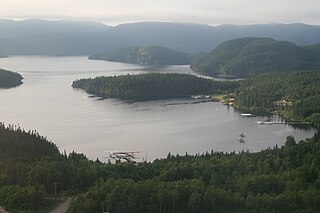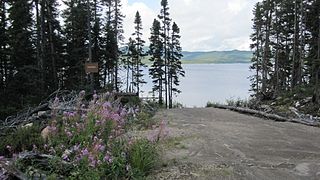
Sherbrooke is a city in southern Quebec, Canada. It is at the confluence of the Saint-François and Magog rivers in the heart of the Estrie administrative region. Sherbrooke is also the name of a territory equivalent to a regional county municipality (TE) and census division (CD) of Quebec, coextensive with the city of Sherbrooke. With 161,323 residents at the Canada 2016 Census, It is the sixth largest city in the province and the 30th largest in Canada. The Sherbrooke Census Metropolitan Area had 212,105 inhabitants, making it the fourth largest metropolitan area in Quebec and 19th in Canada.

Lake Saint Pierre is a lake in Quebec, Canada, a widening of the Saint Lawrence River between Sorel-Tracy and Trois-Rivières. It is located downstream, and northeast, of Montreal; and upstream, and southwest, of Quebec City. The end of the lake delimits the beginning of the estuary of Saint Lawrence.

The Magog River, or Sekosonotek in Abenaki, is a river that drains Lake Memphremagog. It is a small river running through the territories of the cities of Magog and Sherbrooke, in the administrative region of Estrie, in Quebec, in Canada, along a southwest–northeast axis. Having its source in lake Memphremagog, it crosses lake Magog and empties into Saint-François River, in the city center of Sherbrooke.

The Batiscan River is located in La Mauricie administrative region, in the Quebec province, Canada. This river flows 196 kilometres (122 mi) from Lake Édouard in Mauricie south and west to empty into the St. Lawrence River at Batiscan, Quebec, northeast of Trois-Rivières, Quebec. It passes through the regional county municipalities (RCM) of La Tuque, Portneuf, Mékinac and Les Chenaux.

The Montmorency River is a tributary of North-East bank of St. Lawrence river, flowing in the administrative region of Capitale-Nationale, in the province of Quebec, Canada. The course of the river successively crosses the regional county municipality of:
Batiscanie is the watershed of the Batiscan River, located in the center of the province of Quebec, Canada, covering 4690 km² on the North Shore of the St. Lawrence River. The area covered by Batiscanie is 53% in the administrative région of Mauricie and 47% in the administrative region of the Capitale-Nationale.

Lake Saint-Charles is a lake located in the Capitale-Nationale region of Quebec, Canada. It is located partially within the Quebec City borough of La Haute-Saint-Charles and partially within the united township municipality of Stoneham-et-Tewkesbury.
The Blanche River rises in Blanc Lake and flows through the unorganized territory of Lac-Blanc and the municipality of Rivière-à-Pierre in the MRC Portneuf, in the administrative region of Capitale-Nationale, on the North Shore of St. Lawrence River in the province of Quebec in Canada.
The Noire River flows in the municipality of rivière-à-Pierre, Saint-Alban and Saint-Casimir, in the Portneuf Regional County Municipality, in the administrative region of Capitale-Nationale, in Quebec, in Canada.

Aux Rochers River, is a river in Sept-Rivières Regional County Municipality, Côte-Nord, Quebec, Canada. It drains an area of 4,180 square kilometres (1,610 sq mi). It is a tributary of the Gulf of Saint Lawrence

The Schmon River is a river in the Côte-Nord region of the province of Quebec, Canada. It flows south into Lake Walker.

Lake Sainte-Anne is a lake and reservoir on the Toulnustouc River in the territory of Côte-Nord, Quebec, Canada. The original dam was built in 1950 to regulate the river flow as part of the Manicouagan River hydroelectric power complex. A new dam was completed in 2005 that enlarged the reservoir and supported the new Toulnustouc generating station.

The Pentecôte River is a river in the Côte-Nord region or the province of Quebec, Canada. It is a tributary of the Gulf of Saint Lawrence, which it enters beside the community of Rivière-Pentecôte.

The Riverin River is a river in the Côte-Nord region of the province of Quebec, Canada. It is a tributary of the Gulf of Saint Lawrence. There is a small hydroelectric power plant near the mouth of the river.

Lake Cacaoui is a lake in the Côte-Nord region of Quebec, Canada. It drains into the Sainte-Marguerite River.

The Rapides River is a river in the Côte-Nord region of Quebec, Canada. It empties into the Gulf of Saint Lawrence.

The lac des Commissaires flows in the municipality of Lac-Bouchette, in the MRC Le Domaine-du-Roy Regional County Municipality, in the administrative region Saguenay–Lac-Saint-Jean, in Quebec, in Canada. The lake is popular for recreational and tourist activities.

The lac Beauport is a body of water located north of Quebec, surrounded by the municipality of Lac-Beauport, in the La Jacques-Cartier Regional County Municipality, in the region of Capitale-Nationale, in the province of Quebec, in Canada. It covers an area of 0.8 square kilometres (0.31 sq mi), at a maximum depth of 13 meters. The lake outlet flows into the Jaune River.

The Lake McSweeney is a freshwater body located in the Center-East part of Gouin Reservoir, in the territory of the town of La Tuque, in the administrative region of the Mauricie, in the province of Quebec, in Canada.

The Kiamika reservoir is a freshwater body located in the Kiamika Reservoir Regional Park, in unorganized territory of Lac-Douaire, in Antoine-Labelle Regional County Municipality, in the region of Laurentides, in Quebec, in Canada.













